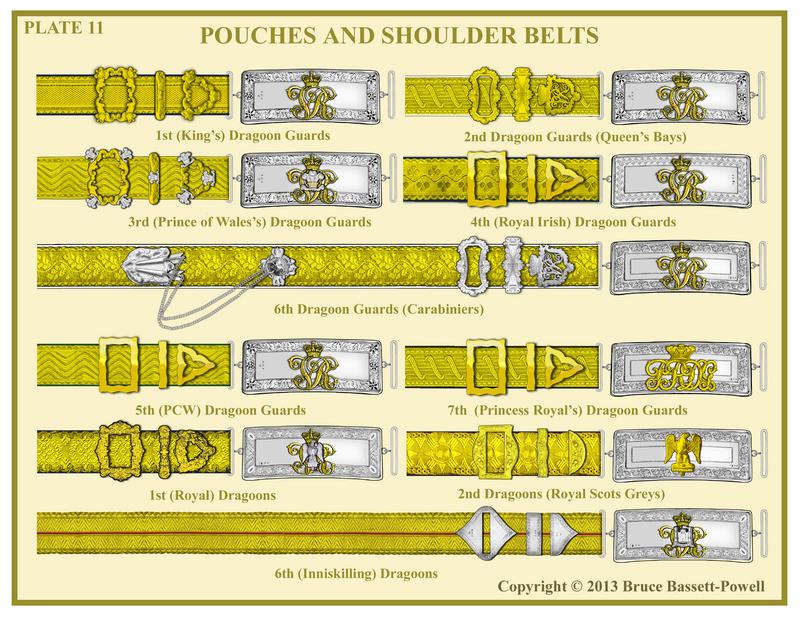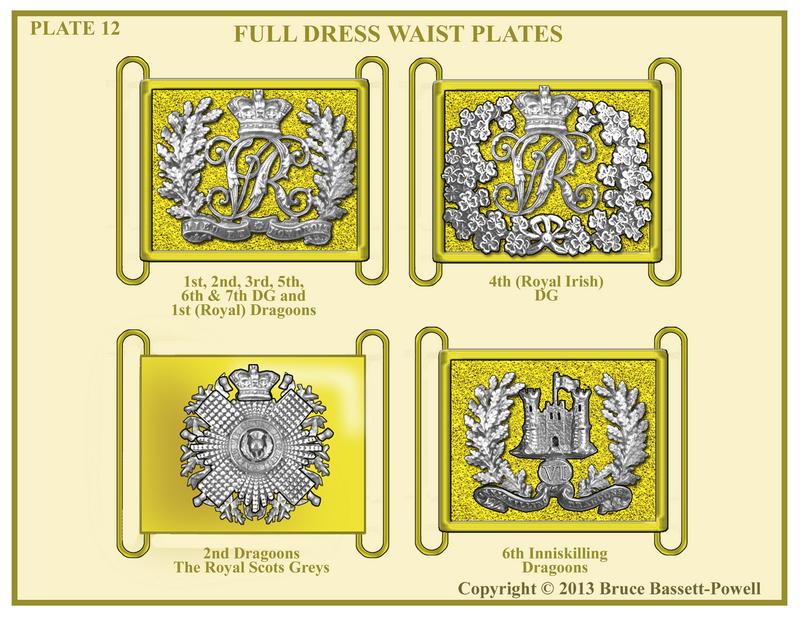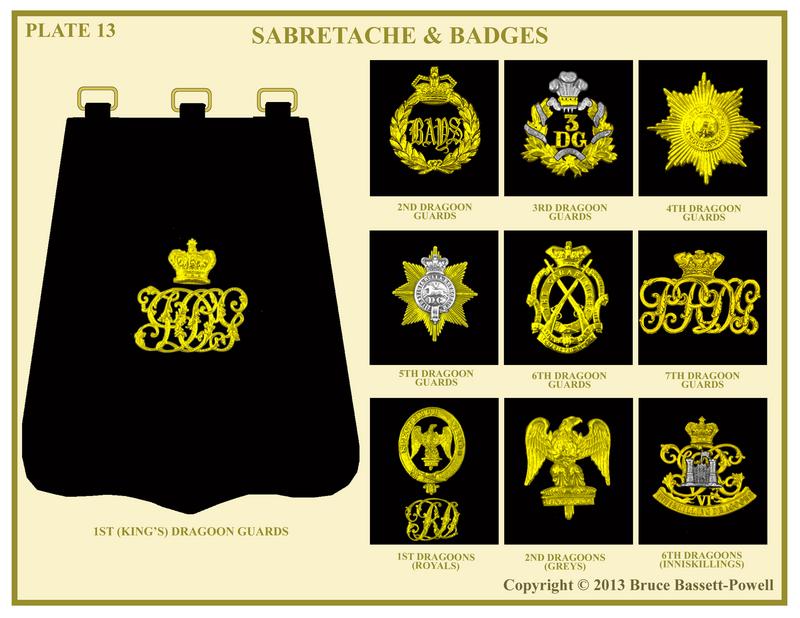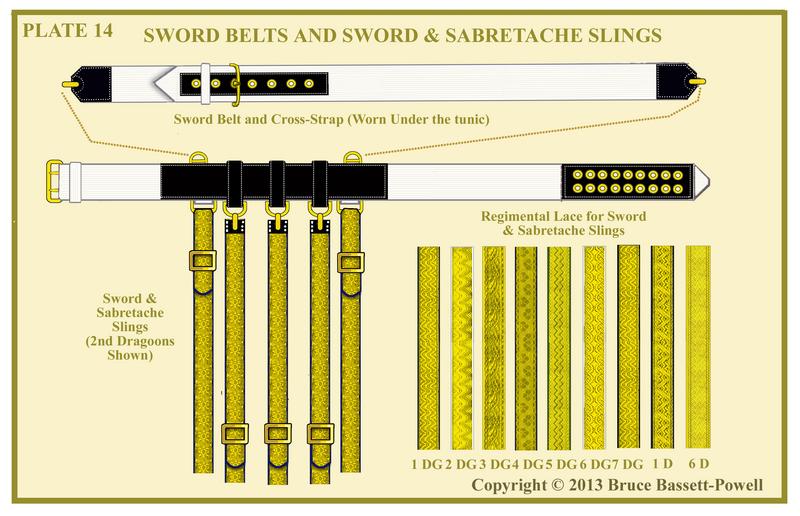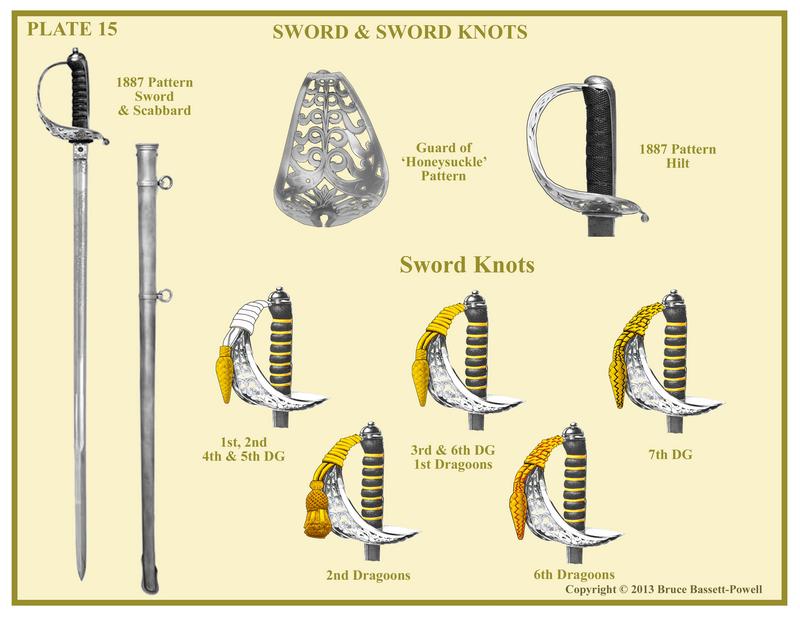HEAVY CAVALRY UNIFORMS, ARMS & EQUIPMENT - DRAGOON GUARDS & DRAGOONS
POUCHES, POUCH BELTS & WAIST BELTS
The full dress pouches and pouch belts (Called Shoulder Belts in Dress Regulations) worn by British cavalry regiments in the nineteenth century had evolved from useful pieces of equipment to hold cartridges and the like to purely decorative items. The pouch was made of black patent leather with a gold lace edging to the top. The top flap was covered with a solid silver rectangle, usually with some floral edging around all four sides and decorated with the cypher of the reigning monarch in gilt, which from 1837 to 1902 was Queen Victoria. This basic pouch was the standard for all cavalry regiments except the Household Cavalry and some notable Hussar regiments.
For Dragoon Guards and Dragoons the silver flaps had the VR cypher except the 7th Dragoon Guards and the 2nd Dragoons (Royal Scots Greys). The etched ornamentation on the silver flaps varied depending on the different silversmiths who made them and whose marks also appeared on the flaps. Most edgings were of a floral nature and the 4th Royal Irish Dragoon Guards at one time had a shamrock pattern, however it seems that there was no compatibility of design within regiments (including the 4th DG). This is probably because they were expensive and the pouch itself probably moved with the owner to a different regiment upon posting, simply changing the gilt device on the flap if necessary. Also, there is no doubt that pouches were handed down to sons and nephews. The devices on the pouches were as follows – (See Plate 11)
1st Dragoon Guards 
 The VR Cypher in gilt
The VR Cypher in gilt
2nd Dragoon Guards 
 The VR Cypher in gilt
The VR Cypher in gilt
3rd Dragoon Guards 
 Silver Prince of Wales’s feathers on the VR Cypher
Silver Prince of Wales’s feathers on the VR Cypher
4th Dragoon Guards 
 The VR Cypher in gilt
The VR Cypher in gilt
5th Dragoon Guards 
 The VR Cypher in gilt
The VR Cypher in gilt
6th Dragoon Guards 
 The VR Cypher in gilt
The VR Cypher in gilt
7th Dragoon Guards 
 “PRDG” in gilt
“PRDG” in gilt
1st Dragoons 

 Silver Eagle over “105” on the VR Cypher
Silver Eagle over “105” on the VR Cypher
2nd Dragoons

 Large gilt Eagle over “Waterloo”
Large gilt Eagle over “Waterloo”
6th Dragoons 

 Silver bullion Castle of Inniskilling on the VR Cypher
Silver bullion Castle of Inniskilling on the VR Cypher
The lace on the pouch belts was of regimental pattern and was 2 ¼ to 2 ½ ins wide. It was laid on a backing of Morocco leather that was the colour of the regimental facings. The 2nd and 7th Dragoon Guards shared the same lace pattern as did the 3rd and 5th. The buckle, tip and slide were gilt for all regiments except the 6th Dragoon Guards and the 6th Dragoons. These were of regimental pattern and one will notice that there were several patterns that were similar in several regiments. The “wavy” set worn by the 4th, 5th & 7th Dragoon Guards was that used by the Household Cavalry and was the most common worn in the cavalry. The 2nd and 6th Dragoon Guards had the same style except that the latter was in silver. The 6th DG also wore the light cavalry pattern chain and pickers on the front of the belt. The 6th Inniskilling Dragoons had a central crimson stripe in the lace.
The waist belt (or girdle as it was called in regulations) was the same pattern as the shoulder belt only slightly narrower at 2 ¼ ins. The only exception to this was that of the Inniskilling Dragoons whose belt was a triple layer of vandyked lace. The belt was secured by a frosted gilt rectangular waist plate with the VR cypher within an oakleaf wreath, all in silver, above a scroll with the motto “Dieu Et Mon Droite”. The 4th DG had the cypher within a wreath of shamrocks and the Inniskillings had the silver Castle above VI instead of the cypher and in the wreath “Inniskilling Dragoons”. The Royal Scots Greys had a special pattern of a plain gilt plate with the star of the Order of the Thistle in silver in the centre. (See Plate 12)
SABRETACHES
The sabretache was another item where usefulness had passed and was largely decorative although the Dress Regulations of 1900 goes into great detail on its construction. Heavy cavalry officers had given up their fabric covered sabretaches in 1855 and adopted the plain black leather undress item bearing a small regimental badge on its face. The sabretache must have been popular with officers as it was not abolished until 1902. (See Plate 13)
SWORD BELT, SWORD & SABRETACHE SLINGS
Photographic evidence shows that heavy cavalry officers had begun to wear their sword belts under the tunic (like hussars & lancers) since the mid eighteen-seventies and it had become universal by 1881. The waist belt had by then become, in essence, a girdle which was the way it was described in Dress Regulations of 1894. At the same time a white canvas belt, reinforced with black leather along with a similar cross-belt for support was described. It was illustrated as a diagram in the 1900 Regulations. . One imagines that, for comfort sake, the cross-belt was not often worn.
The sword and sabretache slings were of regimental gold lace patterns edged in Morocco leather in regimental facing colour and backed with velvet. The illustration shows how they were attached to the sword belt. (See Plate 14)
THE SWORD, SCABBARD & SWORD KNOTS
Heavy cavalry officers had essentially been carrying the same sword pattern since 1821. It had been modified in 1834 when the “Honeysuckle” hilt was introduced and again in 1856 when another scroll hilt was adopted by some regiments. In 1887 the same sword was modified with a stronger blade and the honeysuckle hilt also strengthened and made standard for all cavalry. Hussars, however still managed to hang on to their three-bar hilted light cavalry sabre until 1897.
The sword knot was intended to be worn on the wrist to prevent losing the sword in action. While this was certainly the case for swords carried by other ranks, like much that officers wore at this time, their sword knots were largely decorative. Most regiments knots ended in basket-woven gold lace acorns, but the Royal Scots Greys had a thistle. The 1st, 2nd, 4th & 5th Dragoon Guards had white leather straps attached to the acorn, while the 3rd & 6th Dragoon Guards and the Royal Dragoons had gold lace cords. The 7th Dragoon Guards had a black line woven into the cord and acorn while the 6th Inniskilling Dragoons had a crimson line. (See Plate 15)




